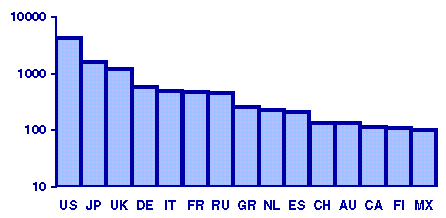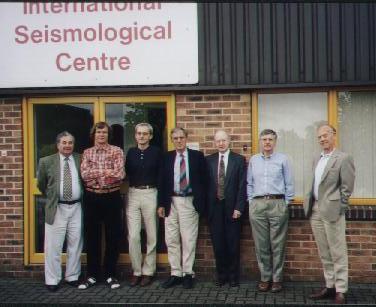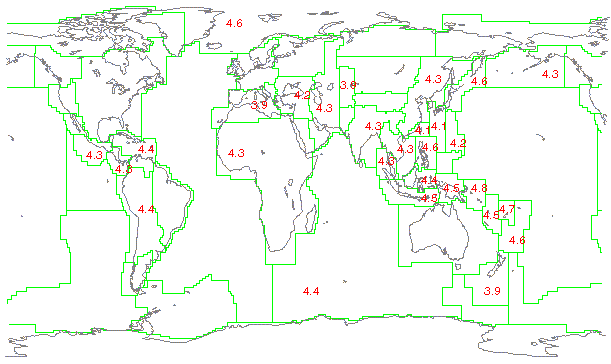

From early May, the 1995 Catalogue has been available from the ISC web site. On the web, the Catalogue is presented as a set of daily files in the provisional GSE 2.1 format. Events from January and February were added to the web site in late June. In the future, the ISC plans to add files for each month as it is completed.
There have already been over 15,000 pages downloaded from our web site. The busiest period so far was just after the IASPEI bulk e-mail announcement of availability of the 1995 Catalogue. Over the 4 days following this announcement, the ISC web server responded to nearly 2000 page requests from over 200 different computers.
A computer's "name" indicates its country only imperfectly, and it is not uncommon for a nameserver to fail to resolve a name from an IP address. Of the requestors for which the ISC can determine a name, however, 30% have a domain suggesting a US site, and 17% a site in Japan. Page requests from Europe are common as well, but visitors to the ISC web site have come from more than 50 countries all around the world.

The ISC Executive Committee met at the ISC on 25-26 June. In addition to the usual topics, the Committee considered a draft development plan for the next several years. The draft plan includes reorganisation of ISC operations to handle to ever-growing volume of data while maintaining the seismological output unchanged. In addition, the Committee recommended that the ISC hold a workshop during 1999 to consider changes in the seismological output of the Centre, such as locations based on new travel time models or relative rather than absolute locations for some events.
Thanks to sleuthing by Axel Roehm of Utrecht University, the ISC learned this quarter that "fake P" readings from the US National Seismic Network had been finding their way into the published ISC Bulletin. In response to an enquiry from ISC's data administrator Anna Surguy, NEIC's Bruce Presgrave described the purpose and properties of these spurious phase readings. Body wave arrivals are required to anchor surface wave amplitudes in the NEIC data management system. Because of high-frequency noise at some USNSN stations, however, it is sometimes possible to measure a surface wave amplitude where no body wave is detectable. To avoid excluding useful amplitudes from the data, P arrivals are inserted into the database with properties that are intended to prevent their use by any careful seismologist, including a large positive travel time residual.
The ISC accepts phase readings from NEIC, and the fake P's are were included. The outcome has almost always been harmless: the association and identification are unchanged, the residual remains large, and the arrival time is automatically assigned an effectively null weight in computing the event location. Occasionally, however, the phase is reassociated or re-identified by an ISC Bulletin editor as pP or sP, potentially leading to an inaccurate event depth.
ISC Deputy Director David McGregor has developed an algorithm to identify the fake P's in NEIC data files with very high confidence. In arrivals from the first 2 months of 1996, the algorithm identified 621 fake P's and a comprehensive manual review of the flagged arrivals showed just one possible mis-identification. From the start of 1996, fake P's will routinely have an operator identification code 111 and a null ISC identification in ISC products, and be neglected in processing.
Fake P's are likely to be have been included in the ISC Bulletin at least back to 1992, and we will be evaluating means for properly identifying these arrivals in the processed data. Further details are available.
Several users of the ISC's new CD have sought advice about the "new" format 15. Format 15 was introduced in last year's CD of the 1994 Bulletin to accommodate 5-character station codes, which is the limit permitted by the FDSN standard. In ISC's format 5, which holds initial phase records, only 4 characters are allocated for the station code. In order to minimise impact on programs developed by users around the world, the extra character was appended to the end of the record in column 94, and initial phase records with the extra character were assigned format code 15. But 5-character station codes did not become common in ISC data until 1995, when GSETT-3 began. Many seismic arrays used in GSETT-3 were assigned 5-character codes, and these heavily used, low-noise stations account for a surprisingly large fraction of arrivals in the 1995 Bulletin. Users of either CD including 1994 or 1995 data may want to update their programs to recognise the new format.
ISC Seismologist Alison Bird represented the ISC at the CGU meeting in Quebec City, 18-22 May, where she presented her paper "Earthquakes in the Queen Charlotte Islands Region: 1992 - 1996". While there, Alison spread the word among Canadian seismologists about recent changes at the ISC and its newest CD. She plans to submit a paper based on the work to the Canadian Journal of Earth Sciences.

Estimating the threshold of the "network" of stations reporting to the ISC from first principles would be challenging. Not only would it be difficult to adequately characterise the noise levels at many stations, the probability of receiving an arrival report depends on operational procedures at more than 2000 stations with limited, voluntary co-ordination.
An alternative is to look for departures of the magnitude-frequency distribution from an approximately log-linear relation. Almost all seismologists agree that the logarithm of earthquake frequency increases more or less linearly as magnitude decreases, except perhaps for very large earthquakes. Thus, a threshold for detecting and computing magnitudes of all earthquakes can be estimated by looking for where the observed frequency falls below a linear extrapolation from higher magnitudes.
Preliminary analysis indicates an mb > 4.0 threshold in most Flinn-Engdahl seismic regions with at least 100 body wave magnitudes. Further details are available.
国产精品无码免费专区午夜_精品无码国产一区二区三区51安_AV无码久久久久不卡蜜桃_在线观看片免费人成视频无码